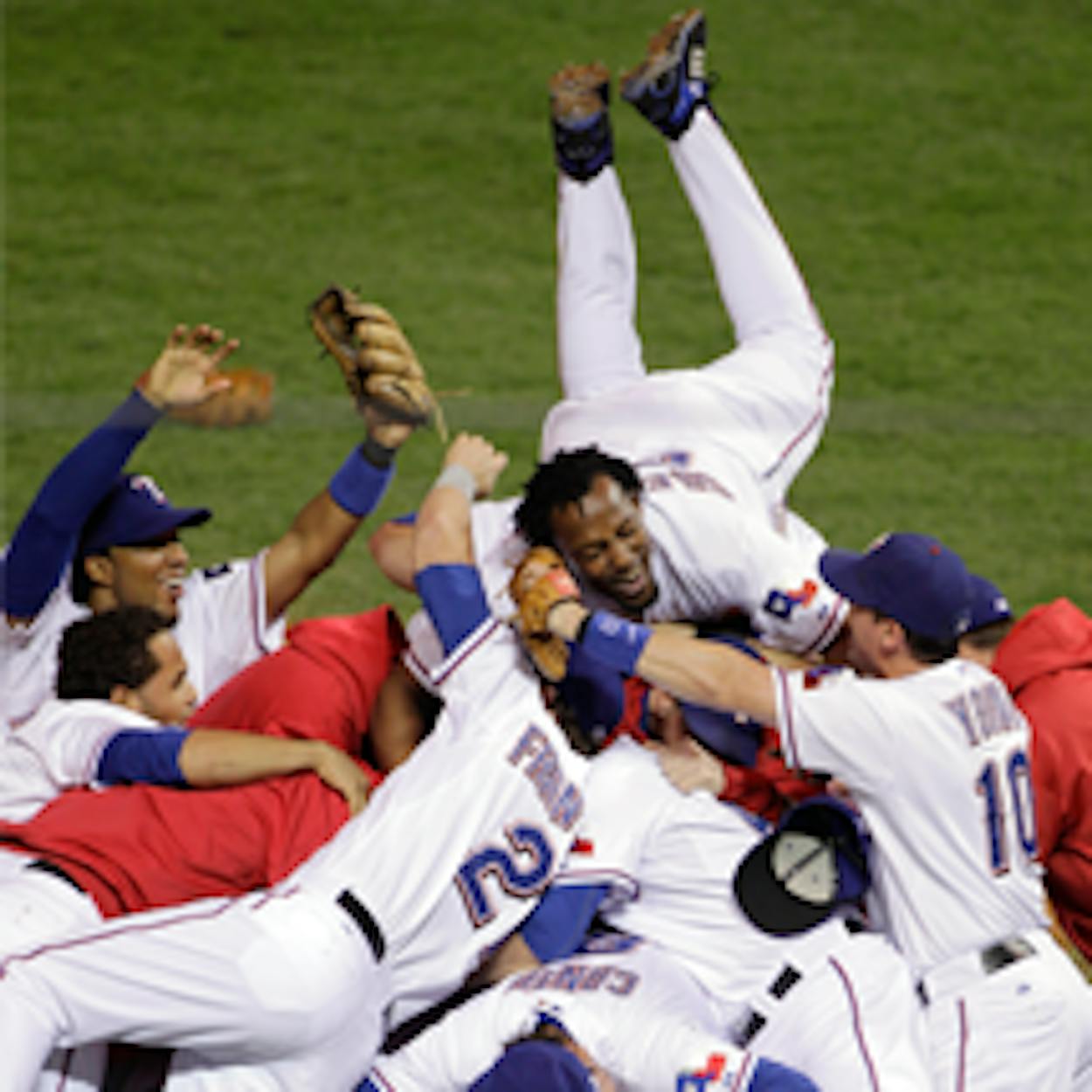After the William Harridge Trophy had been handed over, after the Texas Rangers unfurled the banner reading “2010 American League Champions,” and after fans updated their Facebook status, everyone in Rangers Ballpark in Arlington still looked at each other in amazement and said the same thing: We’re going to the World Series!
The accomplishment was made sweeter by beating the dreaded New York Yankees. Texas had reached the postseason only three prior times in their history, but it was New York who had sent them packing each time. And it was fitting, of course, that the Yankees’ final hitter was Alex Rodriguez, the $252 million symbol of the Rangers’ old free-spending ways. Signed by Texas in 2000 to a ten-year deal, A-Rod never warmed to Texas, bolting Arlington after three years and leaving the team swimming in debt. When the Rangers’ filed for bankruptcy this summer, Rodriguez was still owed about $25 million, making him one of the team’s largest unsecured creditors.
But the win meant a lot more than just settling a grudge. When Neftali Feliz’ final pitch blew past Rodriguez on Friday night, it signaled the arrival of a new era—not only for the team but also for baseball. Nearly forty years after setting up shop in Arlington, the Rangers have finally rebuilt themselves into a team that matters.
But how? What makes this team different? The Rangers playoff teams of the late nineties were packed with sluggers like Juan Gonzalez, Ivan “Pudge” Rodriguez, and Dean Palmer. But they were one-dimensional: When the bats went cold, the pitching staff couldn’t stand on its own. The result was consecutive sweeps in 1998 and 1999, when Texas was shut out four times in six games.
The numbers in this series tell the difference. Texas outscored New York 38-19, and the Rangers’ batting average was .304, compared with the Yankees’ .201. But Texas outpitched New York as well, with a 3.06 earned-run average to the Yankees’ 6.58. The question wasn’t whether the Rangers were the better team, it was how did the Yankees last six games?
While it’s easy to single out the contributions of series MVP Josh Hamilton and pitching ace Cliff Lee, there are three main reasons why Texas was able finally to shrug off the mantle of the oldest franchise never to go to the World Series. First and foremost, Nolan Ryan. Yes, he’s now part-owner of the team, but he’s been the president of the Rangers since 2008. During that time, he’s been molding the team in his image: fit, hard-working, and tough. The pitching staff, which has long been the weak part of the organization, has changed its approach. Starters are expected to work deeper into the game rather than expect the bullpen to bail them out in the fifth or sixth inning. Once a pitcher throws one hundred pitches or more, prevailing wisdom suggests that it’s time to take them out of the game. But Ryan believes less in counting pitches and more in keeping pitchers in shape. A fitness fanatic during his playing days, Ryan has overseen a rugged team training regimen and for the first time since 2006, Texas had two pitchers, C.J. Wilson and Colby Lewis, log more than two hundred innings in a season.
Then there’s Clint Hurdle. The former Colorado Rockies manager signed on as the Rangers’ hitting coach this season to replace Rudy Jaramillo, who had held that job since 1995. During that time, Texas was known as an aggressive slugging team, consistently finishing among the league leaders in batting average, home runs, and runs scored. As the new guy in town, Hurdle worked to gain the players’ trust and convinced them that in addition to bashing the ball around the ballpark, there was value in being more selective and taking more pitches (hear that, Vlad?). The results are impressive: The Rangers led all major league teams with a .276 team batting average, but they also struck out less, walked more, and got on base more often.
And finally there’s Jon Daniels. At 33 years old, the youngest general manager in baseball is living every fantasy baseball geek’s dream. After becoming the Rangers’ GM at age 28, one of his first big moves was to trade second baseman Alfonso Soriano, which paved the way for a young Ian Kinsler to move up. The following year, Daniels traded slugger Mark Teixeira. In return, the Rangers got Feliz and shortstop Elvis Andrus. All three young players—Kinsler, Feliz, and Andrus—were on the field as the Rangers won the AL pennant. No wonder the current rumor is that the New York Mets want to hire Daniels away.
Still, it isn’t just about what happens on the field. It’s about what happens in the front office. The Yankees have the second-oldest roster in baseball and loads of high-priced contracts. Their $206 million payroll is the biggest in the majors. Contrast that with the Rangers, who rank 12th in average age among major-league teams. Feliz and Andrus are 22, and reliever Derek Holland, who played a key role in Game 4, is only 24. Texas began the season with a $55 million payroll, the fourth-lowest in baseball. And instead of a high-priced free agent, the pitcher who shut down the Yankees in the clinching Game 6 was Lewis, who was pitching for the Hiroshima Carp when the Rangers signed to him to a two-year deal.
These are the factors that will come into play this week in the World Series against the San Francisco Giants. The series shapes up well for Texas. Lee has the chance to pitch twice, the entire team gets a few extra days rest, and the Rangers, who have exceeded expectations, will likely be loose and confident. And whatever happens over the next two weeks, the Rangers have already done more than anyone thought possible: They’ve rebuilt themselves and shaken up baseball.
- More About:
- Sports
- Nolan Ryan
- Arlington







